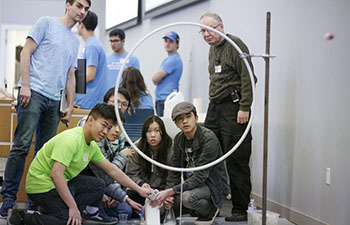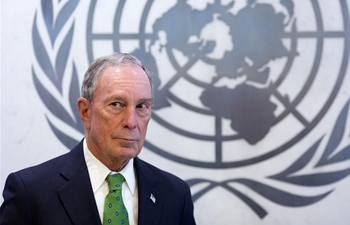by Huang Heng
LOS ANGELES, March 11 (Xinhua) -- "It looks like President Donald Trump has started to do something in order to live up to another aggressive campaign promising to address trade imbalances after the tax reform has been done last year," Dominic Ng, Chairman and CEO of East West Bank, said.
When talking about dispute between the United States and other countries on higher steel and aluminum import tariffs imposed by Washington Thursday, Ng pointed out the domestic political purpose was behind the decision, but the trade deficit problem could be overstated by politicians and lead to a trade war with other countries, including China.
"It's a strange phenomenon that the steel and aluminum tariff issue actually has very small impact on Chinese exporters since only a measly two percent of total U.S. imports of steel products, by value, came from China in 2017," he said in a recent interview with Xinhua at the bank's headquarters in Pasadena City of California. "But most people interviewed by local media in street showed they believed China will feel pain."
According to statistics, Canada is the biggest supplier of steel to the U.S.. In Asia, South Korea accounted for almost 10 percent of all U.S. steel imports last year and Japan for nearly six percent. Meanwhile, the European Union cried so loud because it worries that steel that might've gone to the U.S. will now find its way to Europe, pressuring local steelmakers even further.
"So do you believe the tariff hike will rescue the six big producers left in the country?" Ng doubted, saying it will only result in dispute in the World Trade Organization (WTO) for years.
In the interview, Ng emphasized that even though public opinion in the United States has been turning against free trade, but they would not like a trade war, not to speak of a ridiculous trade war basing on wrong calculation.
"A trade war must have a internecine result," the banker said. His bank, with 36 billion U.S. dollars of assets, was listed by the Forbes in January as one of the top five on the annual list of America's Best Banks 2018.
Ng called on U.S. media, economists and Trump's trade advisers to take their responsibilities to deliver a simple truth to the president and public that the current officially reported U.S.-China trade numbers are grossly inaccurate because they are based on outdated methods of data collection and calculation and have not been properly updated to reflect today's global economy.
"Currently, statistical agencies pin the entire trade value of a product to the last place it was exported from, even though the parts in the product come from many other countries. This method of data collection is based on the International Monetary Fund's Balance of Payments Manual, which was first released in 1948, and never appropriately overhauled to reflect the new complexities of global value chains."
Ng then put his Apple iphone on the table and explained how the iPhone alone may add 17 billion U.S. dollars to the fault trade deficit with China in 2016.
"One iPhone comes from different countries and regions, such as displays are manufactured in South Korea, processors come from the United States, touch ID sensors in Taiwan and barometric pressure sensors from Germany. Final assembly takes place in China," he said.
"Even though work in China is only a tiny fraction of the total manufacturing cost, the entire import cost of the iPhone is attributed to China in U.S. trade statistics."
"It's like a boy sending a box of pizza to your house, he took you 100 bucks, you can't say the boy earned you 100 bucks. He got only very small part from the business, the restaurant, market, farm, everyone are on the chain..."
He said, basing on traditional way, official trade statistics compiled by the U.S. Bureau of Economic Analysis recorded a U.S. net trade deficit with China of 309 billion U.S. dollars in 2016, or 1.7 percent of U.S. gross domestic product (GDP), but if under value-added methods for tabulating trade created by the Organization for Economic Co-operation and Development (OECD), the number will be much lower.
"While data for recent years is not available, if we assume a stable ratio between traditional and value-added data, then the adjusted U.S. trade deficit in 2016 with China would come down from 309 billion dollars to 169 billion dollars," Ng said, adding "it is a much more sensible and useful starting point for discussions about policies to reduce U.S. trade imbalances with China."
Ng's argument was supported by a study from Federal Reserve Bank of Dallas, which shows that using a value-added approach to measure bilateral trade reduces the U.S.-China trade imbalance by 33 percent in 2013.
He also mentioned that public debate largely ignores the U.S. services trade surplus with China and track the negative impacts much more easier than the benefits since the economic globalization is so complicated that it goes far beyond common American's basic knowledge.
"There's no question that trade integration with China has had negative impacts for specific demographics and regions in the U.S., particularly for workers in low value-added manufacturing sectors. However, it is important to keep in mind that the trade deficit with China has also yielded tangible benefits to the United States."
He listed the benefits of trade with China that are often difficult to measure and thus do not receive significant attention, including generating substantial savings for American consumers, hugely benefiting the U.S. from an environmental perspective, and moreover, helping the United States to focus efforts toward higher value-added activities.
"Better statistics would go a long way to help us overcome myths and political gamesmanship, and instead identify and tackle the real problems in the U.S.-China trade relationship," he said, while repeating that trade is just a part of economic cooperation between the two countries.
The key to resolve the trade problem is not trade itself, Ng said, adding a comprehensive cooperation framework is necessary.
"If the two countries work together, they can achieve a lot to the world, from economic development to anti-terrorism operations," he said.
"As long as both sides have the intention of creating a win-win solution, respect the issues they are facing, and proactively and constructively resolve them, this will push the U.S.-China trade relation to be more fair, balanced, and mutually beneficial," he concluded.













